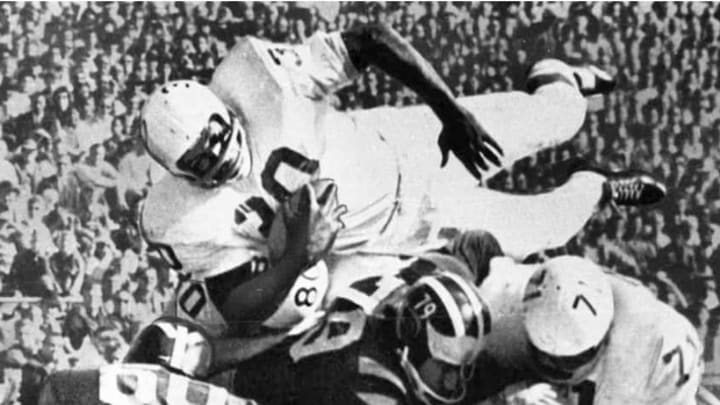The Rise & Fall of the Nebraska Football Dynasty

First in a series of six articles by longtime Husker fan Chris Fort. Here is a little background on Chris.
I was born and raised in Illinois and currently reside in Chicago. I have no ties to the university, unless you count an uncle with a degree from Colorado and a hatred for all things Husker. I was initially intrigued after Black 41 Flash Reverse, but after learning about the sellout streak, Brook’s story, Osborne going for two, etc. I was infatuated. My first game as a fan was the 2001 Buffaloes game – clearly, I’m the bad luck charm. Still, I’m a diehard fan who wholeheartedly believes Nebraska is what college football should be.
In late October 2001, the Nebraska Cornhuskers met their old foe Oklahoma on Tom Osborne Field under a clear blue sky. It was their 80th time lining up against one another and this time promised to be a classic for the ages. Oklahoma came in the reigning national champions and winners of twenty straight, a number two ranking in the Associated Press poll. Nebraska, too, came in undefeated, winners of their last nineteen in Memorial Stadium and ranked number three in the country. ESPN’s College Gameday crew set up shop outside an endzone, extolling the virtues of each team to a national TV audience and playing clips from classic OU-NU games. Fans filed into the stadium early in their scarlet and cream with signs that said, “Vote for Crouch,” echoing chants of ‘Go Big Red’ from North Stadium to South. The stage was set.
A defensive struggle ensued, the clacking of pads and the grunts from the trenches being picked up on the ABC broadcast. With the Huskers clinging precariously to a 13-10 lead in the 4th quarter, thoughts turned to “Big Game” Bob Stoops, the hot young coach who presided over a title in just his second year and boasted an 8-0 record against top ten opponents. How would he work his Sooner Magic to break Husker hearts? On the other sideline stood the diminutive Frank Solich, in his fourth year as head coach, with questions hanging over him as to whether he’d ever be a worthy successor to Bob Devaney and Tom Osborne. The coach who once fudged his weight as a player always did struggle measuring up.
Solich bucked his conservative reputation and sent in a trick play. You know the one – Black 41 Flash Reverse. Quicksilver quarterback and Heisman hopeful Eric Crouch hiked the ball from under center and handed it to Thunder Collins, who was motioning from the left side of the field on an end around. Converted wideout Mike Stuntz had rolled from his receiver post to the backfield and took the pitch from Collins. He twisted the ball in his hand to get the laces without breaking step, cocked back his left arm, and lofted a beautiful spiral to Crouch, who had snuck out of the backfield undetected and was now striding down the sideline. The Nebraska bench went wild, players leaping high into the air, shouting themselves hoarse as an elated crowd of 78,000 woke the dead with their deafening cheers. Crouch rumbled to the end zone untouched to secure the victory, the Heisman Trophy, and a berth in the fabled Rose Bowl. To date, it is the last time the Cornhuskers have defeated a Top 5 opponent.
2001 is a demarcation line in Husker annals: there is before and there is after. In the 40 years immediately preceding 2001, Nebraska recorded forty winning seasons and, for thirty-three consecutive years spanning 1969 to 2001, won no fewer than nine games each season—a remarkable feat during an era when eleven-game seasons were the norm. Aside from a combined three weeks of absences (1 in 1977 and 2 in 1981), Nebraska appeared in every AP Top 25 poll released from week 7 of 1969 until week 6 of 2002. They finished in the top 10 of either the AP or Coaches poll in 30 of those 40 years; three quarters of the time, fellow coaches or journalists thought the Huskers among the ten best in the country. During this period, Nebraska won twenty-two conference championships and five national championships (and left several others unclaimed), amassing a total of 398 victories, 44 more than Penn State and 46 more than Alabama, who rank as second and third place, respectively, during the same period.
The Huskers did this despite their inherent recruiting challenges and despite the ground shifting throughout the decades - scholarship limits squeezing tighter and tighter, recruiting scandals at neighboring schools, and changing academic requirements by the NCAA.
How did Nebraska, a state with a small population and limited recruiting base, achieve such dominance in college football? The answer to the big red riddle lay in the very fabric of the state’s origins, whose residents embodied the rugged spirit of their pioneer forebears. Nebraska cultivated excellence on the gridiron much like the early settlers cultivated the state’s tough farmland: with stubborn determination and a daring to do what hadn’t been done before. This mindset, coupled with the strategic brilliance of coaches Bob Devaney and Tom Osborne, created the "Big Red Machine," a finely tuned enterprise engineered for unparalleled success, designed to demoralize opponents and calibrated to punish.
But the end came as swiftly as the rise. Post-2001, Nebraska’s football program saw a precipitous decline in its play on the field. The signs of decay were visible before 2002, but the Huskers were still cloaked in their aura of invincibility. The fall from grace was marked by the end of their prized streaks and the dismantling of a coaching staff whose roots traced back to the 1960s. Fans who had grown accustomed to dominance were left in shock, their pride replaced with bewilderment and frustration. Reasons for the Big Red breakdown have been bandied about barstools and internet forums for a generation but never definitively stated. Until now.
The Rise
Ignition
To get to the end, we must first start at the beginning. Prior to legendary coach Bob Devaney’s ascendance to the head role in 1962, Nebraska was mired in two decades of middling-to-below-average play that yielded just three winning seasons, a slide that started at the onset of World War Two when students went off to war and only programs with robust military training programs were able to assemble competent teams. Things became so bleak that in 1960 beleaguered Husker coach Bill Jennings told an Omaha crowd, “I don’t think this state can ever be great in anything .”
Nebraska was not devoid of traditional excellence prior to Devaney’s arrival and the start of the 40-year dynasty. This was a program that stymied the great Red Grange, that dealt the mythical Four Horsemen of Notre Dame their only collegiate losses, that didn’t incur a defeat for three straight seasons (1913 - 1915), and that, until the forties, averaged better than a sixty-eight-win percentage in every decade. Nebraska had a rich history that was all but forgotten by the time JFK took office.
Devaney instilled belief in the thirty-eight Huskers who suited up in Ann Arbor his first year against the heavily favored Michigan Wolverines. They heard laughs rain down from the Wolverine faithful. And why wouldn’t they? Nebraska had lost 125 games in the last 20 years, second most in the country, and only managed a single finish in the AP Top 25 poll. But a de-cleating hit by Bill 'Thunder" Thornton let the Wolverine faithful know that this Husker outfit was different. Thunder cracked several more ferocious hits and rolled for two touchdown runs, propelling Nebraska to a lead they’d never relinquish and a victory that registered across the country. “The Cornhuskers of Nebraska chugged along like a well-oiled threshing machine,” read the Detroit News the next day.
And under Devaney and his protégé Tom Osborne, it rarely stopped chugging. In eleven seasons as head coach, Devaney went 101-20-2, winning eight conference titles and two national championships. The sellout streak began later that first year when Missouri visited Memorial Stadium. Nebraska would finish the season winning the Gotham Bowl in frigid Yankee Stadium against the University of Miami, the school’s first ever bowl win and the cap to the first of forty consecutive winning seasons.
But it all started with the ’62 Michigan win, Devaney’s biggest according to the man himself. A spark had been lit in the state of Nebraska. The machine had ignition.
Related:
2004 Bill "Thunder" Thornton interview
1962 Nebraska vs. Michigan game page
Next up: Recruiting and Development Rise
Stay up to date on all things Huskers by bookmarking Nebraska Cornhuskers On SI, following HuskerMax on X, and visiting HuskerMax.com daily.
